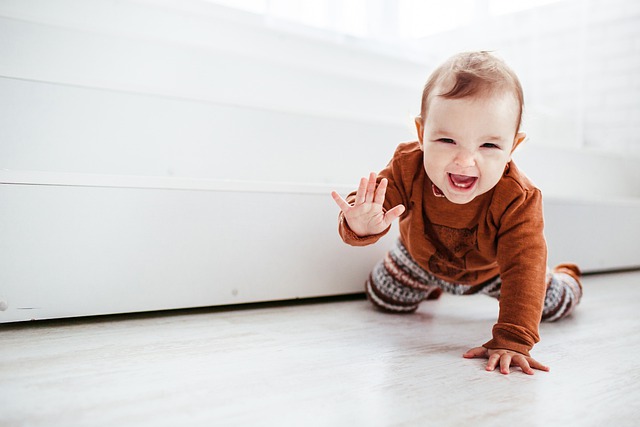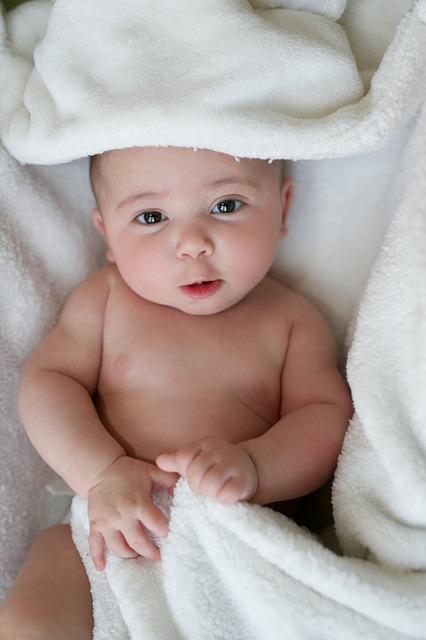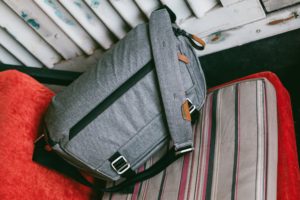I wasn’t sure I was going to write this blog because focusing on baby milestones in the first year can be intimidating and, if not careful, send the wrong message. We have so much pressure to parent perfectly that I was worried that I would just be adding to that overwhelm. However, I also find baby milestones to be incredibly interesting. So I’ve decided to write this anyway. Just know that all children grow at their own pace and that all of these milestones are approximate ages.
Development
Your baby’s brain is going to grow, change, and develop no matter what you do. But there are basic, everyday things you can do to help their little minds develop optimally. And it doesn’t even involve spending money!
Learning Through Play
Children learn through play and experiences. So this means that sitting and doing flash cards with them is not going to be as effective as physically exploring items together. Make learning fun! Even just being and playing and exploring is huge for your child at this age. A walk through the house where you talk and name things, or laying together on the carpet and giggling these are all building connections in those fascinating little brains.
Touch
I could spend all day nerding about the positive benefits of physical touch. Gentle touch gets your baby’s brain firing! It’s also great for soothing, building attachment, and even helping them feel better when they are sick (anytime my babies were sick, it was clothes off for both of us, naked couch cuddles. Ah, I miss those days.). Touch activate their brains and helps them learn and absorb more.
Talking
Your voice is going to be one of the most interesting, most well known sounds to your child. Anything you say is exciting, even if your little one doesn’t understand it. Talk to your child. Talk about anything, everything, or even nothing.
Read (link to Reading coming Winter, 2021)
Oh no, run away, she’s talking about reading again. Yeah, it’s what I do. I cannot stop talking about how great for baby’s brain reading is. It exposes them to pictures, sound, touch (if they are sitting with you while you read), and quality time with you. Books offer new vocabulary, new experiences, and interesting content.
Responsiveness
One of our biggest responsibilities as new parents is to teach our children that the world they are in is safe. This way their energy can go to learning, not on trying to figure out how to stay alive. This means responding to your child’s cues. If they cry, check in with them. If they get hurt, comfort them. If they are scared, support them. Being responsive teaches your child that they are not alone in this very big, very scary world. It teaches them it’s okay to be curious, to explore, to play and to learn.

Milestones
Okay, now it’s time to get into some milestones. These widely accepted milestones are generated by the CDC and you can view their website here. They even have a checklist for these milestones, to help keep you focused.
2 Months
In a lot of ways, 2 months is a huge turning point. Your baby is moving away from the helpless newborn phase. They are starting to interact with their world and develop little personalities.
Social/Emotional
- Can briefly calm self (ma bring hands to mouth to suck on, for example)
- Begins to smile
- Tries to look at a parent
Language/Communication
- Coos and makes gurgling sounds
- Turns head towards sounds
Cognitive
- Pays attention to faces
- Begins to follow things with eyes
- Recognizes people at a distance
- Begins to express boredom
Physical
- Can hold head up
- Begins to push up when lying on tummy
- movements with arms and legs are smoother
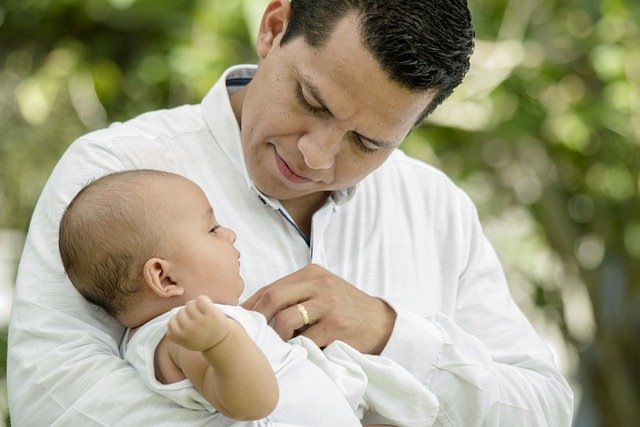
Development Tips
- Cuddle and play with your baby, especially during routine times such as feeding, dressing, and bathing.
- Start that routine now!
- Smile and respond when your baby makes sounds.
- Copy your baby’s sounds, but also use clear language.
- Talk, read, and sing to your baby.
- Play peek-a-boo.
- Play with mirrors, either together or getting a baby safe mirror for them to look at themselves on their own.
- Look at pictures together and talk about what you see.
- Give lots of opportunities for tummy time.
- Hold a toy above your child’s head while they are laying down and encourage them to reach for it.
4 Months
Your baby may start to plump up at this age if they haven’t started already. Their communication skills will take a turn as it seems like they are trying more and more to communicate with you. In general they are starting to become more and more social.
Social/Emotional
- Smiles spontaneously, especially at others
- Copies some movements and facial expressions, such as smiling
- Likes to play with others
Language/Communication
- Begins to babble
- Babbles with expressiion
- Cries in different ways to show different needs (such as hunger vs pain)
Cognitive
- Expresses simple emotions more clearly, such as happy or sad
- Responds to affection
- Reaches for a toy with one hand
- Uses hand and eyes together, such as seeing a toy and reaching for it
- Follows moving things with their eyes from side to side
- Watches faces closely
- Recognizes familiar people at a distance
Physical
- Holds unsupported head steady
- May be able to roll over from tummy to back
- Brings hands to mouth
- Can hold a toy and shake it
- When lying on stomach, pushes up to elbows
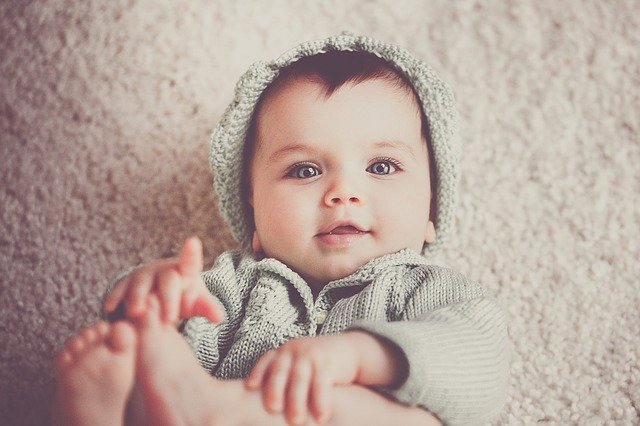
Development Tips
- Hold and talk to your baby often.
- Routine, routine, routine.
- Pay attention to what your baby likes and doesn’t like.
- Copy your baby’s sounds.
- Have quiet play time when you read or sing to your baby.
- Offer age appropriate toys to play with.
- Provide safe opportunities for your baby to explore their surroundings.
- When lying on the floor, put toys near your baby so they can reach for them or kick them with their feet.
- Put rattles and other toys in your baby’s hands and help them hold them.
6 Months
This is your halfway point for the first year. If your child isn’t hitting some of the earlier milestones yet, it may be appropriate to bring them to a doctor. Your doctor should be asking you questions about their development at each of your visits as well.
Social/Emotional
- Knows familiar faces and begins to know if someone is a stranger
- Likes to play with others, especially primary caregivers
- Responds to other people’s emotions and often seems happy
- Likes to look at self in a mirror
Language/Communication
- Responds to sounds by making sounds
- Strings vowels together when babbling and likes taking turns with parent while making sounds
- Responds to own name (or nickname, whatever you call them most frequently)
- Makes sounds to show joy and displeasure
- Begins to say consonant sounds such as “m” and “b”
Cognitive
- Looks around at things nearby
- Shows curiosity about things and tries to get things that are out of reach
- Brings things to mouth
- Begins to pass things from one hand to the other
Physical
- Rolls over front to back and back to front
- When standing, supports weight on legs
- Begins to sit without support
- Rocks back and forth when on hands and knees
Development Tips
- Play on the floor with your baby every day.
- Listen to your baby’s moods and cues, such as continuing if they are happy or adjusting when they are upset.
- When your baby smiles, return the smile.
- Repeat your child’s sounds and say simple words with those sounds, such as “bah” turns into “bottle” or “book”.
- Read to your child every day.
- When you notice your baby looking at something, point to it, talk about it, and if safe, let your child engage with it.
- Start exploring cause and effect. When your child drops something on the floor, pick it up and give it back. I do not recommend practicing this concept at meal times.
- Point out and name new things you see.
- Place your baby on their tummy or back and put toys just out of reach. Encourage rolling over to reach those toys.
9 Months
Your baby might be starting to get vary mobile at this age. You’re going to start seeing crawling, pulling up, and sitting up on their own. A word of caution against push toys or encouraging your child to walk. The crawling stage is incredibly important developmentally (you can read more about it here), so don’t try to rush your child through it.
Social/Emotional
- May be afraid of stangers
- May be clingy with familiar adults
- Has favorite toys
Language/Communication
- Understands no
- Makes a lot of different sounds
- Copies sounds and gestures of others
- Uses fingers to point at things
Cognitive
- Watches the path of something as it falls.
- Looks for things they see you hide.
- Plays peek-a-boo
- Puts things in their mouth
- Moves things smoothly from one hand to the other
- Picks up things like cereal o’s between thumb and index finger
Physical
- Stands, holding on
- Sits without support
- Crawls
- Can get into sitting position from lying down
- Pulls to standing
Development Tips
- Pay attention to the way your baby reacts to new situations and people. Be responsive and supportive.
- Them routines again! Make sure you feel good about yours.
- Play “my turn, your turn” games.
- Name what you think your baby is feeling, such as “happy”, “sad” or even “angry”.
- Describe what your baby is looking at.
- Name what your baby wants when they point to things.
- Copy baby’s sounds and words.
- Ask for behaviors that you want. For example, instead of saying “don’t stands,” say “time to sit”.
- Roll balls or cars back and forth.
- Give your child a container and a few toys to let them practice filling and dumping.
- Play peek-a-boo and hide-and-seek.
- Provide lots of room for your baby to move and explore in a safe area.
- Put your baby close to things they can safely pull up onto.
1 Year
You made it! You’ve found yourself on the other side of 1. Your child is going to quickly become a toddler from here, with more advanced needs, emotions, and opinions.
Social/Emotional
- Is shy or nervous with strangers
- Cries when parents leave
- Has favorite things and people
- Shows fear in some situations
- Hands you a book when they want to hear a story
- Repeats sounds or actions to get attention (this includes negative attention)
- Puts out arm or leg to help with dressing
- Plays games such as peek-a-boo and pat-a-cake
Language/Communication
- Responds to simple spoken requests
- Uses simple gestures like shaking head no or waving goodbye
- Makes sounds with changes in tone (sounding more like speech)
- Says “mama” and “dada”
- Tries to say words you say
Cognitive
- Explores things in different ways, such as shaking, banging, or throwing
- Finds hidden things easily
- Looks at the correct picture or thing when it is names
- Copies gestures
- Puts things in a container and takes them out
- Bangs two things together
- Starts to use things correctly, such as drinks from a cup or brushes hair
- Lets things go without help
- Pokes with index finger
- Follows simple one step directions
Physical
- Gets to a sitting position without help
- Pulls to a stand, walks holding onto furniture
- May take a few steps without holding on
- May stand alone
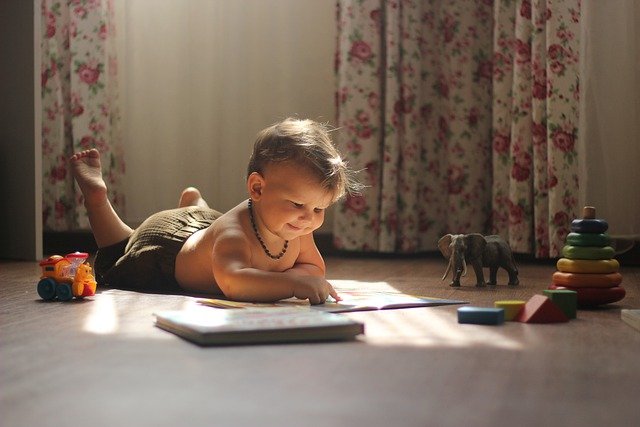
Development Tips
- Give your child time to get to know a new caregiver.
- Avoid starting daycare now if you haven’t already.
- In response to unwanted behavior, give your child a firm “no”. Do not yell, spank, or give lengthy explanations.
- Give your child lots of affection.
- Spent more time encouraging wanted behaviors than punishing unwanted behaviors. Aim for a 4:1 ratio.
- Talk to your child about what you are doing while you are doing it.
- Read with your child every day. Let them turn the pages. Label pictures together.
- Build on what your child says or points to.
- Give your child crayons and paper and let them draw freely.
- Play with blocks, shape sorters, and other toys that encourage your child to use their hands.
- Hide small toys and have your child find them.
- Ask your child to label body parts.
- Sing songs with actions and help your child do the actions with you. Think songs such as “Itsy Bitsy Spider” and “Wheels on the Bus”.
- Give your child musical instruments and encourage them to make noise.

